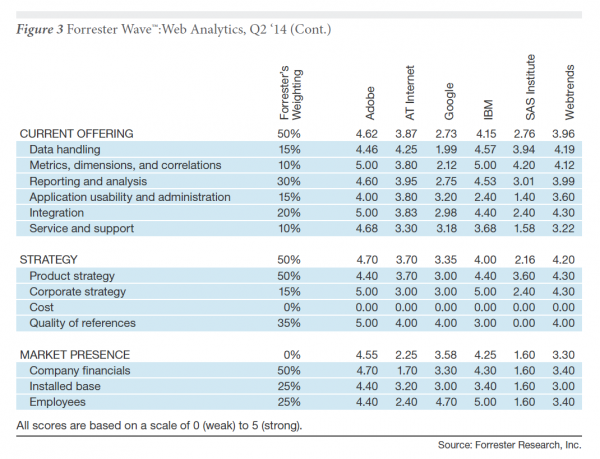Forrester Wave for Web Analytics is Out, Some Question Its Accuracy

Forrester releases its Wave for Web Analytics Q2, 2014, taking us through the six providers that they believe matter the most. Who’s on the list? Well, some of these won’t surprise you:
- Leaders: Adobe, AT Internet, IBM, Webtrends
- Competitive Option: Google
- Alternative Option for Existing Customers: SAS Institute
We’ll talk a bit about these six vendors in a minute, but let’s look at the web analytics industry overall before we do that.
The Evolution of Web Analytics
As Forrester notes, web analytics has gone through a slow evolution, but it remains the dominant method for measuring digital activity and as a result, it “underpins digital intelligence.” Not that long ago, I talked with Bruce Kenny, EVP Product and Engineering, Webtrends about its evolution, which has in some ways always been inline or a step ahead of the rest of the industry. He talked about how web analytics has evolved and where it’s going, and Forrester’s view is the same.
As enterprises capture more data about customers from a wide range of data sources, they need to have a way to analyze it and create actions from it. Web analytics solutions have grown to be able to connect all these data sources, and some have even made the data available to other applications via APIs and other services. Moving a little further along the spectrum and we see some vendors have started to integrate offline data into their platforms to provide a 360 degree view of the customer.
Getting the data into some format that makes it actionable I think is the bigger challenge today. Marketers are responsible for analytics today – not only being able to report on the basics, but also being able to translate those numbers into actionable insights – and that’s a tough job for someone who’s traditionally been more “creative” than “analytical.” To help, vendors offer reports for web, mobile, social and in some cases, mobile apps – they aren’t all the same.
Forrester also talks about the need for a “customer-centric” view of the data. It’s become standard to report on unique visitors volumes, and do that across channels and/or sessions, but the difference is with those which are able to recognize individual visitors and match them across various interaction trails that are anonymous – this is that ability to create a full view of an individual, across channel/device so a personalized experience can be created. This one is something that the bigger vendors are working on (and some have achieved to varying levels).
Predictive analytics has become the biggest differentiator in the battle for leadership in web analytics. I know Webtrends offers it, Google offers it, Adobe recently announced it offers it in the latest version of Adobe Analytics (which this report is based on). Again, all aren’t identical, so you need to look close at that’s there.
One thing Forrester points out is that there has to be a balance of tracking/reporting (and managing that data) with customer’s privacy and the portability of that data. I suspect that will be an on-going discussion foever, but it’s certainly one enterprises need to consider carefully, and plan into their analytics strategy.
The Analytics Evaluation
The vendors in this report were evaluated against a range of capabilities and services, along with their forward thinking strategy and market presence. Here’s a snapshot of how each one ranked:
Some key points about each vendor from Forrester’s evaluation:
- AT Internet – (which to be honest I have never heard of) – is focused in Europe, working on its presence in Russia, Latin America, and Southeast Asia.
- Adobe – What was formerly Omniture is now a broader set of analytics (with the addition of a few acquisitions) and Adobe Analytics is part of the broader Adobe Marketing Cloud bringing analytics integration throughout the Adobe ecosystem.
- IBM – IBM’s broader analytics (once Coremetrics) runs under it’s marketing, commerce and customer experience platforms.
- Webtrends – the only true pure-play vendor in this report has focused its full attention on analytics and the idea of “democratizing data”. It’s also known for it’s real-time data streams (although it’s no longer alone in that service offering).
- Google – listed as strong performer is called out for its ease of use, and rapid time to value. Note it was Google Analytics Premium that was evaluated for this report.
- SAS Institute – Offers existing customers an alternative that integrated with its platform.
So do the results surprise you? Based on some of the feedback around the industry, people seem unhappy. Set aside questions of favoritism (which I don’t think Forrester would do) and you see many people question Google’s location in the “challenger” section. Consider that Google is constantly innovating and bringing new capabilities to the market and you wonder why it doesn’t deserve a set at the leaders table. The fact that it was the Premium edition evaluated might have had a role in its placement.
I doubt there is anyone who question’s Adobe’s placement. In the last couple of years we have it grow an already leader (Omniture) into an integrated offering across its complete Marketing Cloud, and some required new capabilities in predictive analytics, and live data streams. I think Webtrends continues to deserve a set at the table as well, if for no reason than it’s been ahead of many in the live data streams and predictive analytics features. It’s approach to integrate with other complementary platforms is also a smart move as many CXM Vendors build/integrate their own digital analytics into their platforms. As for IBM, it is doing some pretty interesting things that unfortunately seem to get lost in its sheer size. Knowing that it’s working on a broader view of analytics across it’s solution is good to hear though, so I’ll have to look a little more at what’s happening there. As for the other two – I don’t know them, so I won’t speculate on their inclusion.
The biggest complaint I’ve heard? Why is Forrester calling it Web Analytics? It’s not standalone web traffic anymore – it is part of a bigger digital analytics discussion. Boxing it in seems dangerous for companies that don’t understand the difference (and they are out there).
Share and Enjoy
Related Articles
Hippo Takes an Intelligent View of Web Content Management
Hippo is not gearing up its own Marketing Cloud. Instead, the Amsterdam based WCM vendor, is focusing its attention on
Share and Enjoy
AgilOne Introduces Integrated Predictive Marketing Cloud
AgilOne introduces version 5 of its marketing cloud with a number of new updates, and predictive marketing.
Share and Enjoy
Forrester Examines Digital Experience Challenges and Priorities: Yes, They Do Exist
A sponsored Forrester research brief crossed my desk related to the challenges organizations face implementing digital experiences and I thought






